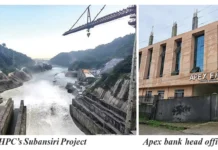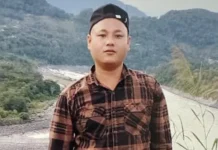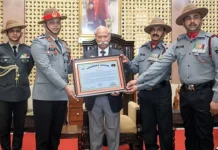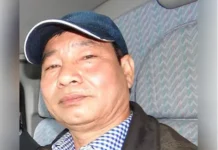[ Niyang Pertin ]
In the verdant folds of Arunachal Pradesh, Siang district has quietly scripted a revolution – one rooted in cleanliness, community spirit, and a vision for sustainable transformation.
As part of the national Swachhta Hi Seva-2024 campaign, Siang – under the inspiring leadership of Deputy Commissioner PN Thungon – embarked on a mission to develop at least one clean model village (CMV) in each of its nine administrative circles, showcasing collective participation and unwavering purpose.
Against this backdrop, the deputy commissioner launched the campaign. Twelve villages were selected, each granted Rs 1 lakh from the DC and supplemented by an additional Rs 1 lakh from the respective ADCs, with complete administrative autonomy.
The district administration sent ‘swachhta captains’ from each selected village to Mawlynnong – Asia’s cleanest village – in Meghalaya. Armed with practical ideas and renewed motivation, these swachhta captains returned to their villages, ready to act as catalysts for change.
Pagak village in Kaying circle was the first to be inaugurated as a CMV on 21 December, 2024. Under the leadership of Kaying EAC Pooza Sonam, and supported by initiatives like ‘Project 37’, Pagak transformed itself by introducing compost pits, 5 LED lights, household dustbins, a ‘hawa ghar’, and even an ‘I Love Pagak’ installation, among many other innovative features. Pagak’s success set a powerful precedent, demonstrating that the CMV vision was achievable.
Three villages, one vision
As the circle officer of Pangin, I oversaw CMV transformation in three villages -Pangin (encompassing the villages of Pangin Moruk and Pangin Moli), Lokpeng, and Kebang Solè.
Today, with Pangin CMV inaugurated and Kebang Solè nearing completion, it’s easy, in hindsight, to trace a linear roadmap to success. But real transformation rarely unfolds that way. It’s shaped by constant learning, human complexities, and shared effort.
Each village possessed its own specific set of socio-cultural nuances, distinct challenges, inherent strengths, and latent possibilities. Pangin village alone is substantial, spanning more than 100 households. Lokpeng comprises around 50 households, while Kebang Solè has about 30 households. There could be no one-size-fits-all template. Our approach had to be adaptive and deeply localised.
From guidelines to ownership
With the guidance of ArSRLM’s Pangin BMM Karik Yirang, the journey began with detailed transect walks to understand the unique needs of each village. What followed was not a copy-paste solution but a tailored strategy – one for each village.
The subsequent months were a whirlwind of activities marked by village meetings in community halls, countless late-night phone calls coordinating logistics, and a constant process of active listening.Through this engagement, we quickly realised that for the transformation to be sustainable, it could never be imposed from the top down. It had to be deeply owned, driven, and cherished by the community itself.
The newly formed Village Development Committees (VDC) became the operational backbone of the movement, comprising gaon burahs, panchayat leaders, youths, and members of SHGs. This flexible approach proved successful because it identified and empowered existing local leadership structures,rather than attempting to impose a uniform, external template.
The district administration provided clear guidelines on public hygiene standards and control of stray animals. In Pangin and Lokpeng, although stray pigs were largely controlled, some pigsties remained close to the main village paths, posing hygiene concerns.
However, Kebang Solè presented a more significant challenge. The sight of stray pigs rooting through garbage, combined with a general lack of cleanliness in public areas, painted a stark picture to the clean village we were striving to create.
Addressing this required sensitivity and persistence. Despite initial resistance rooted in long-held habits, patient dialogue and collective agreement helped villagers take ownership of the problem. By mid-January 2025, they had collaboratively built enclosed pigpens away from main thoroughfares.
Similarly, in Pangin, pigsties along the road were voluntarily relocated.
Sustainability and convergence
It is worth acknowledging that the success of the CMV initiative depended not on a singular effort but on the convergence of multiple departments, each contributing its own resources, expertise, and willpower.
From the ArSRLM’s grassroots engagement to the Veterinary Department’s vaccination drives, RWD’s support and PHED’s grey-water awareness campaigns, the collective effort was remarkable.
The Forest, Horticulture, and Agriculture Departments distributed saplings, while the MGNREGA funded drain construction. Even the Sports Department installed an open-air gym in Pangin. Every department played vital roles, making them co-authors of this success story.
A standout moment was when the GPCs of Pangin Moruk and Pangin Moli, both ‘swachhta captains’, inspired by their exposure visit to Mawlynnong, initiated the installation of iron dustbins and decorative outdoor lights, respectively. With the proposals approved through gram sabhas and funded by the panchayat’s SOR, this grassroots decision had a lasting impact.
The spirit of collaboration extended beyond official channels. One single phone call was all it took to bring Jimu Mele, AE, UD & Housing, Roing and co-founder of Emudu Trekkers, to Kebang Solè and Pangin. His passion, fuelled by his work on Anini’s 7 Lakes Trek, ignited a spark in the villages. What started as a visit soon blossomed into a shared journey, and today, he is no longer an outsider – he’s embraced as one of their own.
Perhaps the most significant, albeit intangible, shift was in the community’s perception: government schemes were no longer viewed as sporadic handouts but as valuable investments in their collective future -resources to be leveraged strategically for community betterment. This transformation in perception was, in many ways, the movement’s quietest but most powerful victory.
The community: Unwavering heart of the movement
This entire endeavour was never meant to be one-time, intensive cleanliness drive that would fade with waning enthusiasm. Instead, it was designed as a catalyst for a lasting paradigm shift in mindset and daily habits.
A wave of transformation followed, powered by the community’s hands and hearts. They undertook extensive avenue plantation drives. The revival of the Ruteng stream in Pangin – once an eyesore -became a community project, alongside the development of an artificial pond nearby.
Embracing Adi craftsmanship, villagers installed intricate bamboo fencing, bamboo bins and wooden seats with traditional Adi protective shade. Public spaces were enhanced with an open-air gym, iron benches, and street lighting. A cherished outcome was the construction of a scenic viewpoint in Pangin, made possible by the generous land donation from elder Taja Tali. Traditional ‘hawa ghars’ were built to provide respite for community and visitors, while a beautiful bamboo bridge and playful tree-houses showcased local ingenuity. The community diligently carried out even basic maintenance tasks, such as repainting the welcome gates and undertaking crucial repairs and dredging of PMGSY drains.
The ‘Donate a plant for a greener future’ campaign brought in saplings, seeds, and support from across the state – but it was the villagers who audited every rupee, proving that transparency doesn’t need enforcement – it needs ownership.
The road ahead: From clean villages to tourism hubs
What began as a movement for cleaner, more sustainable villages has evolved into a vision to transform Siang’s rural communities into vibrant, culturally – rich tourism hubs. By working closely with the Tourism Department, the endeavour is to create a responsible, rural tourism circuit that not only attracts visitors but also stimulates the local economy, and empowers the communities to take charge of their own future.
On the critical issue of lack of skilled manpower in the district, the district administration is tackling this head-on. Collaborating with the Skill Development and Entrepreneurship Department, the NIMAS, and with the support of minister Ojing Tasing and MLA Talem Taboh, the district has sent two batches of youths, comprising over 50 candidates, for a training programme for adventure travel guides at the NIMAS in West Kameng. By the time this article reaches the readers, the first batch will have returned to Siang, fully equipped to become integral players in the district’s tourism landscape.
Further, discussions are underway with local brands to co-create market linkages that will ensure fair trade for local products. Souvenir hubs are aimed to be established in key locations, providing both a market for local artisans and a place for visitors to take home a piece of Siang’s culture.
The road ahead is ambitious, but with the collective efforts of all stakeholders, the aim is to transform these CMVs into powerful symbols of progress, sustainability, and community pride.
The real triumph: Ownership and hope
When I walk these paths now – through Pangin, Lokpeng, or Kebang Solè – I no longer feel like an officer overseeing a project. I feel like a witness to something deeply human and quietly revolutionary. The change is no longer in banners or slogans – it’s in the way a child picks up a wrapper, the way elders speak of ‘before’ and ‘after’, the way villagers now speak of their village with pride and possibility.
DC Thungon’s vision ignited the first flame. But the fire that fuelled the movement came from the people, those who built with their bare hands, gave their time, land, and heart, and now stand as custodians of something greater than themselves.
This journey has humbled me, teaching me that real development doesn’t arrive with fanfare – it unfolds slowly, often invisibly, through conversations, through shared meals, conflict resolved with patience, and above all, through trust earned over time.
If we’ve built anything enduring here, it’s not just clean villages – it’s a community that believes in its own power to build, to lead, and to dream. And that, to me, is the true model we should all aspire to. (The contributor is Circle Officer, Pangin)




